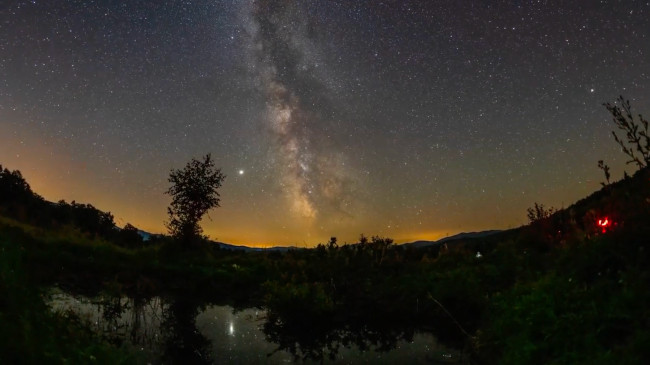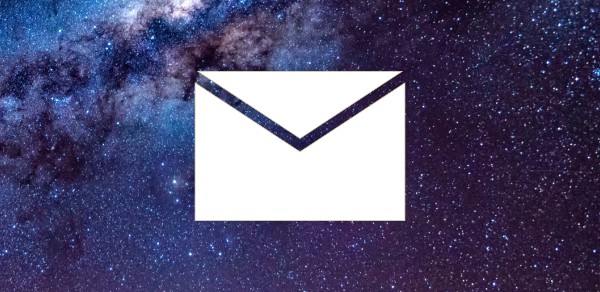This page describes a video Flowing Night Sky
Video caption:
Honourable mention in the 2022 IAU OAE Astrophotography Contest, category Time lapses of celestial patterns.
This time-lapse was shot from Slovakia in August 2020. By fixing the relative movement of the sky to Earth's rotation in some of the frames, we can experience a different perspective as a viewer.
The Milky Way, our home galaxy, is visible throughout the whole video. The bright objects near the Milky Way are Jupiter and Saturn, close together, Jupiter being the brighter one.
This video also shows the interaction of amateur astronomers observing the Perseids meteor shower with their telescopes pointed towards the sky. An unfortunate aspect of the art of astronomical observing, clouds can suddenly cover the whole sky. The fog occurs mostly because of the higher humidity after the rain.
Most of the light trails in the sky are made by satellites, but some of them, appearing just very briefly and not very noticeably, are meteors, as the video was shot around the peak of Perseids meteor shower.
Scroll to captions in other languages
Video credit:
Robert Barsa/IAU OAE
DOI: 10.5281/zenodo.7425689
Related glossary terms:
Jupiter
, Milky Way
, Saturn
, Shooting Star
Categories:
Milky Way and Interstellar Medium
, Naked Eye Astronomy
, Stars
Video license: Creative Commons Attribution 4.0 International (CC BY 4.0) Creative Commons Attribution 4.0 International (CC BY 4.0) icons
The media file captions presented on the OAE website were written, translated and reviewed by a collective effort from the OAE, the OAE Centers and Nodes, the OAE National Astronomy Education Coordinators (NAECs) and other volunteers. You can find a full list of credits for our translation project here. All media file captions are released under a Creative Commons CC BY-4.0 license and should be credited to "IAU OAE". The media files themselves may have different licenses (see above) and should be credited as listed above under "credit".
Captions in Different Languages:
Video caption: Lobende Erwähnung beim IAU OAE Astrofoto-Wettbewerb 2022, Kategorie Zeitraffer von Himmelsmustern.
Dieser Zeitraffer wurde im August 2020 in der Slowakei aufgenommen. Teilweise wird in den einzelnen Sequenzen die relative Bewegung des Himmels zur Erdrotation festgehalten, so dass wir als Betrachter*innen eine andere Perspektive erleben.
Unsere Heimatgalaxie, die Milchstraße, ist während des gesamten Videos zu sehen. Die hellen Objekte in der Nähe der Milchstraße sind Jupiter und Saturn, die dicht beieinanderstehen, wobei Jupiter der hellere ist.
Das Video zeigt auch das Treiben von Amateurastronom*innen, die mit ihren Teleskopen beobachten und den Nachthimmel fotografieren. Ein Aspekt der astronomischen Beobachtungskunst ist, dass Wolken plötzlich den ganzen Himmel bedecken können. Der Nebel entsteht meist durch die höhere Luftfeuchtigkeit nach dem Regen.
Die meisten der Lichtspuren am Himmel stammen von Satelliten, aber einige von ihnen, die nur sehr kurz und unauffällig erscheinen, sind Sternschnuppen, denn das Video wurde um den Höhepunkt des Perseiden-Meteorstroms herum aufgenommen.
Video credit: Robert Barsa/IAU OAE
Related glossary terms: Jupiter , Milchstraße , Saturn , Sternschnuppe Caption translation status: Not yet approved by a reviewer
Caption translators: Carolin Liefke
Video caption: Menzione d'onore al concorso di astrofotografia IAU OAE 2022, categoria Time lapses of celestial patterns.
Questo time-lapse è stato ripreso dalla Slovacchia nell'agosto 2020. Fissando il movimento relativo del cielo alla rotazione della Terra in alcuni fotogrammi, possiamo sperimentare una prospettiva diversa come spettatori.
La Via Lattea, la nostra galassia natale, è visibile in tutto il video. Gli oggetti luminosi vicino alla Via Lattea sono Giove e Saturno, vicini tra loro; Giove è il più luminoso dei due.
Questo video mostra anche l'interazione di astronomi dilettanti che osservano lo sciame meteorico delle Perseidi con i loro telescopi puntati verso il cielo. Un aspetto spiacevole dell'arte dell'osservazione astronomica è che le nuvole possono improvvisamente coprire l'intero cielo. La nebbia si verifica soprattutto a causa della maggiore umidità dopo la pioggia.
La maggior parte delle scie luminose nel cielo sono prodotte dai satelliti, ma alcune di esse, che appaiono solo molto brevemente e in modo poco evidente, sono meteore, dato che il video è stato girato intorno al picco della pioggia di meteore Perseidi.
Video credit: Robert Barsa/IAU OAE
Related glossary terms: Giove , Saturno , Stella cadente , Via Lattea Caption translation status: Approved by a reviewer
Caption translators: Valentina La Parola
Caption reviewers: Rodolfo Canestrari









